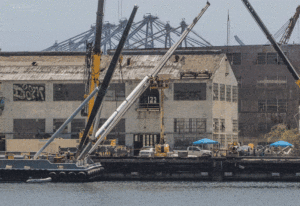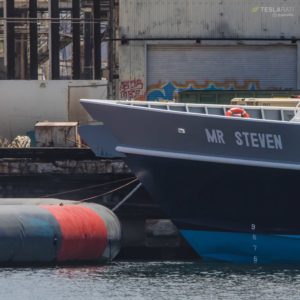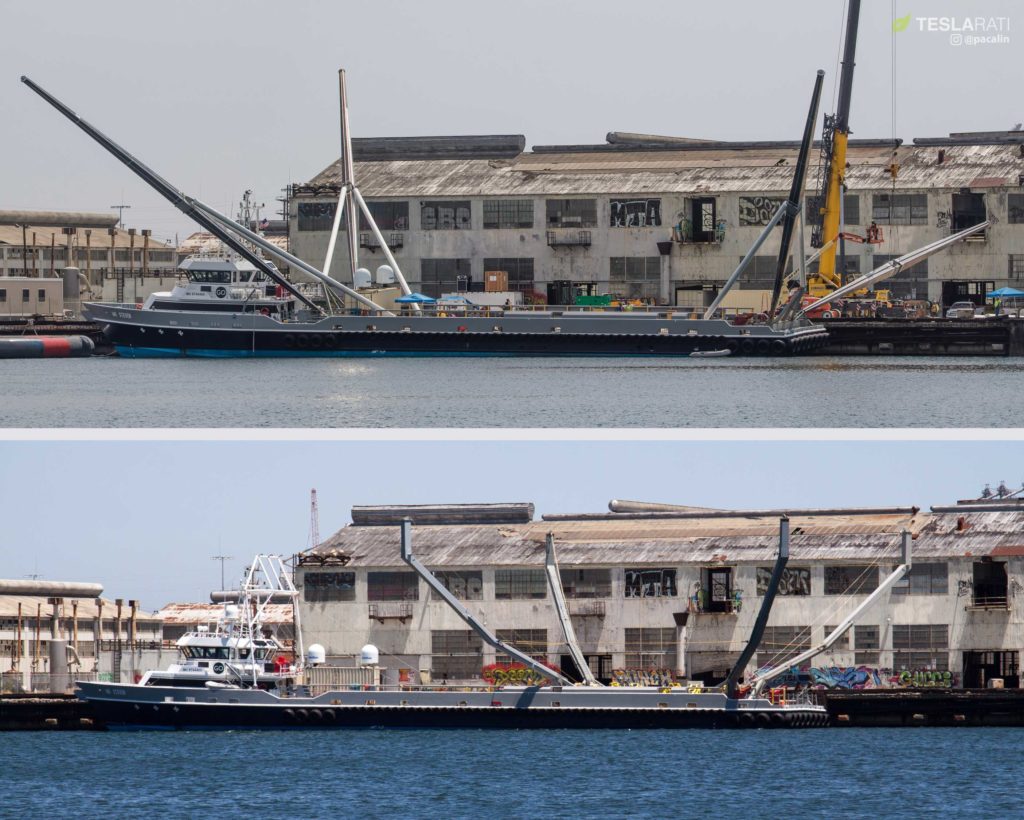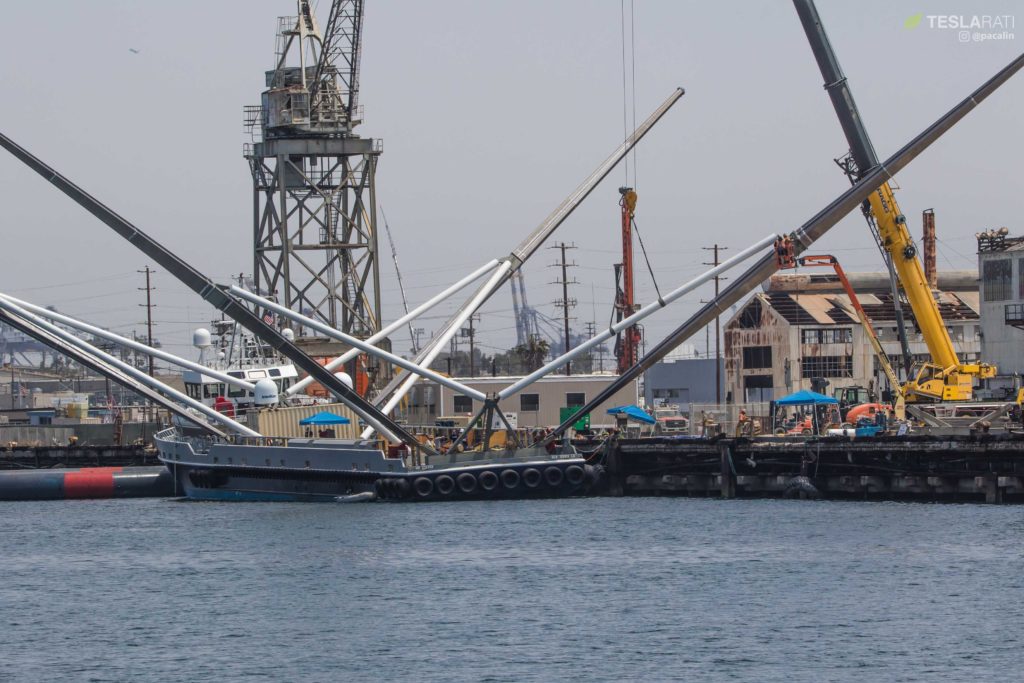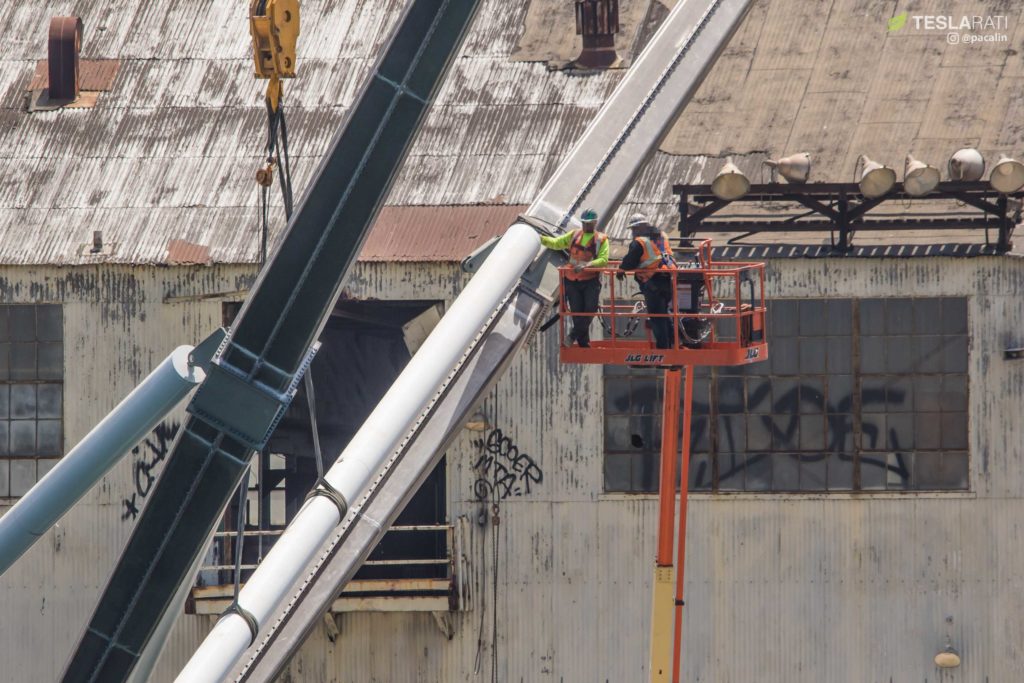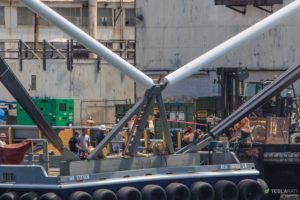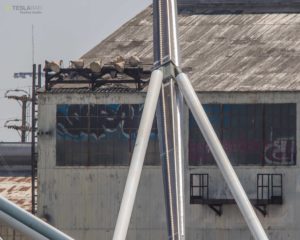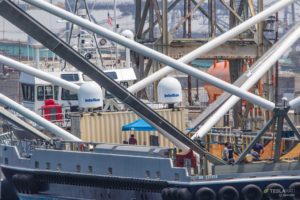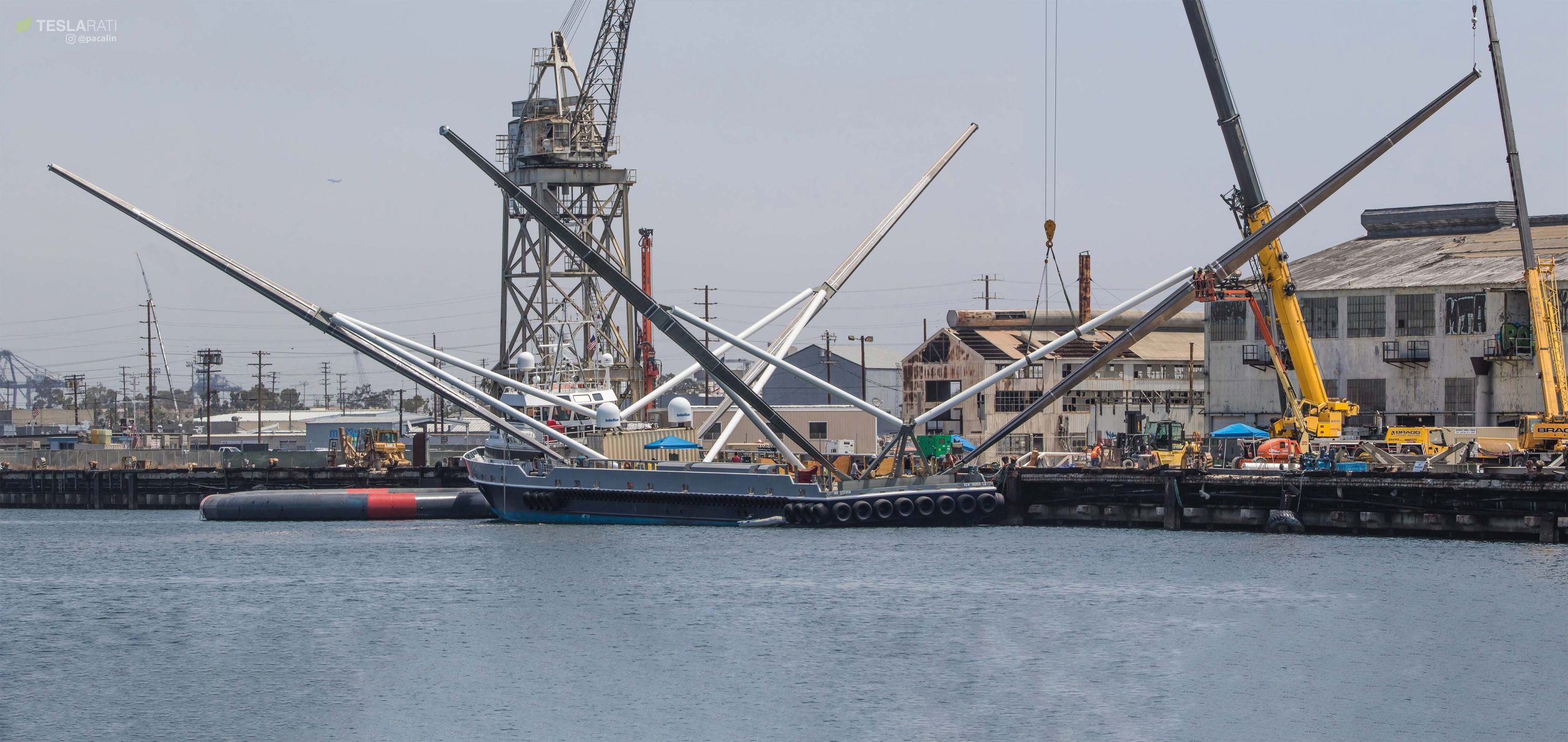
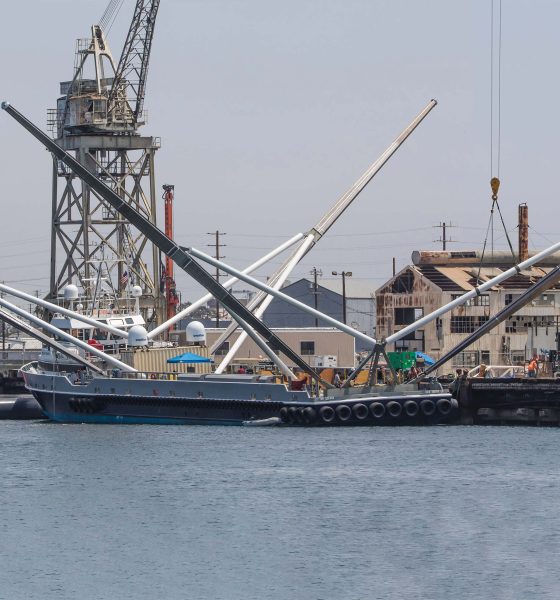
News
SpaceX completes vast Mr Steven arm upgrades for quadruple-sized net
Scarcely 48 hours after they began, SpaceX technicians have already completed installation of all four of Falcon fairing recovery vessel Mr Steven’s new and dramatically larger arms, as well as eight giant struts. All that remains to be installed is an upgraded net, said by CEO Elon Musk to have four times the area of its predecessor.
Put simply, it’s difficult to express how large these upgraded arms really are, and photos still only give a partial sense of their scale. SpaceX technicians busy installing the new arms on July 10th nevertheless offer a fleeting appreciation of the true size of this new payload fairing recovery apparatus, which will hopefully see its first operational debut in just two weeks with a fairing recovery attempt after the Iridium-7 Falcon 9 mission, July 25th.
- A few SpaceX technicians examine one of Mr Steven’s newly-attached arms and struts. (Pauline Acalin)
- Mr Steven and the ever mysterious inflatable ring now floating at Berth 240, July 10. (Pauline Acalin)
All arms on deck
While it’s difficult to estimate from photos alone, it appears that Mr Steven’s new arms are minimum of roughly 65 meters squared, assuming a square aspect ratio. In other words, the vessel’s next and newest net could have an area as large as 3600 square meters (~40,000 square feet, ~0.85 acres), easily more than quadruple the size of Mr Steven’s previous net. For comparison, the massive autonomous spaceport drone ships (ASDS) SpaceX often recovers its Falcon 9 and Heavy boosters aboard have a usable landing area of roughly 45,000 square feet, a little more than 10% larger than Mr Steven’s new net.
With these vast new arms, struts, and (soon enough) net, SpaceX is likely as close as they have ever been to successfully catching a Falcon 9 fairing, an achievement that would likely allow the company to begin reusing the large carbon fiber-composite shrouds almost immediately. Critically, although SpaceX appears to have begun attaching recovery hardware to both fairing halves in recent West Coast attempts, it remains to be seen whether Mr Steven’s new claw apparatus will be able to catch both halves, thus closing the gap on fairing recovery without necessitating the leasing and modification of perhaps three additional copies of the vessel.
- A before and after comparison of Mr Steven’s old and new arms. (Pauline Acalin)
- Even at this zoom, the human workers are difficult to make out. (Pauline Acalin)
- E N H A N C E. (Pauline Acalin)
Adding three recovery-critical ships (two for West Coast missions, two for East Coast missions) to SpaceX’s already massive blue-water fleet could significantly raise the operating costs of each recovery attempt, as well as generally adding considerable complexity to the orchestration of those fleets come launch time. Perhaps not. Still, if Mr Steven sees success with his 4Xed net and arms, chances are very good that SpaceX will lease and modify another Fast Supply Vessel – if they already haven’t done so – to provide the company’s higher-volume East Coast launch facilities with their own, dedicated fairing catcher. Mrs Steven awaits…
- A few more arm and strut glamour shots, July 10. (Pauline Acalin)
- A few more arm and strut glamour shots, July 10. (Pauline Acalin)
- Port of San Pedro or an Andrew Pollock painting? You be the judge. (Pauline Acalin)
Zeroing in on Falcon fairings
Worth noting, SpaceX may have already halved the error margin officially advertised for the parafoil guidance units it procured from Canadian supplier MMIST, apparently missing Mr Steven by about 50 meters while MMIST suggests a 50% chance of successfully landing a payload in a 100-meter sphere. Given the significant expense likely incurred by designing, building, installing, and testing two distinct net and arm systems aboard Mr Steven, it’s safe to say that SpaceX engineers and technicians believe there is a very strong chance that the newest solution will successfully close the fairing recovery gap, said by CEO Elon Musk to be a rather literal 50 meters between the vessel’s old net and the unforgiving ocean surface.
With an additional 30 meters (~100 feet) of reach in both axes, the new net alone may be able to shrink that error margin by ~60%. Perhaps the fact that it also appears to cover (and thus protect) Mr Steven’s wheelhouse will allow the vessel more leeway to aggressively maneuver as the fairing nears touchdown, providing that final 20-meter leap to slip his net under the fall halves.
In the meantime, we will ponder who exactly SpaceX is procuring a 40,000 square foot net from.

Incredibly, this artist rendering of a much larger net installed on Mr Steven was perhaps two or more times smaller than the solution now installed on the vessel. (Reese Wilson)
Follow us for live updates, peeks behind the scenes, and photos from Teslarati’s East and West Coast photographers.
Teslarati – Instagram – Twitter
Tom Cross – Twitter
Pauline Acalin – Twitter
Eric Ralph – Twitter

Elon Musk
Starlink passes 9 million active customers just weeks after hitting 8 million
The milestone highlights the accelerating growth of Starlink, which has now been adding over 20,000 new users per day.

SpaceX’s Starlink satellite internet service has continued its rapid global expansion, surpassing 9 million active customers just weeks after crossing the 8 million mark.
The milestone highlights the accelerating growth of Starlink, which has now been adding over 20,000 new users per day.
9 million customers
In a post on X, SpaceX stated that Starlink now serves over 9 million active users across 155 countries, territories, and markets. The company reached 8 million customers in early November, meaning it added roughly 1 million subscribers in under seven weeks, or about 21,275 new users on average per day.
“Starlink is connecting more than 9M active customers with high-speed internet across 155 countries, territories, and many other markets,” Starlink wrote in a post on its official X account. SpaceX President Gwynne Shotwell also celebrated the milestone on X. “A huge thank you to all of our customers and congrats to the Starlink team for such an incredible product,” she wrote.
That growth rate reflects both rising demand for broadband in underserved regions and Starlink’s expanding satellite constellation, which now includes more than 9,000 low-Earth-orbit satellites designed to deliver high-speed, low-latency internet worldwide.
Starlink’s momentum
Starlink’s momentum has been building up. SpaceX reported 4.6 million Starlink customers in December 2024, followed by 7 million by August 2025, and 8 million customers in November. Independent data also suggests Starlink usage is rising sharply, with Cloudflare reporting that global web traffic from Starlink users more than doubled in 2025, as noted in an Insider report.
Starlink’s momentum is increasingly tied to SpaceX’s broader financial outlook. Elon Musk has said the satellite network is “by far” the company’s largest revenue driver, and reports suggest SpaceX may be positioning itself for an initial public offering as soon as next year, with valuations estimated as high as $1.5 trillion. Musk has also suggested in the past that Starlink could have its own IPO in the future.
News
NVIDIA Director of Robotics: Tesla FSD v14 is the first AI to pass the “Physical Turing Test”
After testing FSD v14, Fan stated that his experience with FSD felt magical at first, but it soon started to feel like a routine.

NVIDIA Director of Robotics Jim Fan has praised Tesla’s Full Self-Driving (Supervised) v14 as the first AI to pass what he described as a “Physical Turing Test.”
After testing FSD v14, Fan stated that his experience with FSD felt magical at first, but it soon started to feel like a routine. And just like smartphones today, removing it now would “actively hurt.”
Jim Fan’s hands-on FSD v14 impressions
Fan, a leading researcher in embodied AI who is currently solving Physical AI at NVIDIA and spearheading the company’s Project GR00T initiative, noted that he actually was late to the Tesla game. He was, however, one of the first to try out FSD v14.
“I was very late to own a Tesla but among the earliest to try out FSD v14. It’s perhaps the first time I experience an AI that passes the Physical Turing Test: after a long day at work, you press a button, lay back, and couldn’t tell if a neural net or a human drove you home,” Fan wrote in a post on X.
Fan added: “Despite knowing exactly how robot learning works, I still find it magical watching the steering wheel turn by itself. First it feels surreal, next it becomes routine. Then, like the smartphone, taking it away actively hurts. This is how humanity gets rewired and glued to god-like technologies.”
The Physical Turing Test
The original Turing Test was conceived by Alan Turing in 1950, and it was aimed at determining if a machine could exhibit behavior that is equivalent to or indistinguishable from a human. By focusing on text-based conversations, the original Turing Test set a high bar for natural language processing and machine learning.
This test has been passed by today’s large language models. However, the capability to converse in a humanlike manner is a completely different challenge from performing real-world problem-solving or physical interactions. Thus, Fan introduced the Physical Turing Test, which challenges AI systems to demonstrate intelligence through physical actions.
Based on Fan’s comments, Tesla has demonstrated these intelligent physical actions with FSD v14. Elon Musk agreed with the NVIDIA executive, stating in a post on X that with FSD v14, “you can sense the sentience maturing.” Musk also praised Tesla AI, calling it the best “real-world AI” today.
News
Tesla AI team burns the Christmas midnight oil by releasing FSD v14.2.2.1
The update was released just a day after FSD v14.2.2 started rolling out to customers.

Tesla is burning the midnight oil this Christmas, with the Tesla AI team quietly rolling out Full Self-Driving (Supervised) v14.2.2.1 just a day after FSD v14.2.2 started rolling out to customers.
Tesla owner shares insights on FSD v14.2.2.1
Longtime Tesla owner and FSD tester @BLKMDL3 shared some insights following several drives with FSD v14.2.2.1 in rainy Los Angeles conditions with standing water and faded lane lines. He reported zero steering hesitation or stutter, confident lane changes, and maneuvers executed with precision that evoked the performance of Tesla’s driverless Robotaxis in Austin.
Parking performance impressed, with most spots nailed perfectly, including tight, sharp turns, in single attempts without shaky steering. One minor offset happened only due to another vehicle that was parked over the line, which FSD accommodated by a few extra inches. In rain that typically erases road markings, FSD visualized lanes and turn lines better than humans, positioning itself flawlessly when entering new streets as well.
“Took it up a dark, wet, and twisty canyon road up and down the hill tonight and it went very well as to be expected. Stayed centered in the lane, kept speed well and gives a confidence inspiring steering feel where it handles these curvy roads better than the majority of human drivers,” the Tesla owner wrote in a post on X.
Tesla’s FSD v14.2.2 update
Just a day before FSD v14.2.2.1’s release, Tesla rolled out FSD v14.2.2, which was focused on smoother real-world performance, better obstacle awareness, and precise end-of-trip routing. According to the update’s release notes, FSD v14.2.2 upgrades the vision encoder neural network with higher resolution features, enhancing detection of emergency vehicles, road obstacles, and human gestures.
New Arrival Options also allowed users to select preferred drop-off styles, such as Parking Lot, Street, Driveway, Parking Garage, or Curbside, with the navigation pin automatically adjusting to the ideal spot. Other refinements include pulling over for emergency vehicles, real-time vision-based detours for blocked roads, improved gate and debris handling, and Speed Profiles for customized driving styles.
